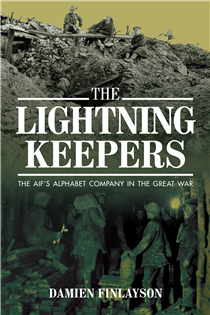It was entirely appropriate that the AE&MM&BC should be commonly known as the ‘Alphabet’ Company in the Great War rather than the Australian Electrical and Mechanical Mining and Boring Company. Damien Finlayson is a mining engineer who has previously written the definitive work on the companion Australian Tunnelling Companies (Crumps and Camouflets: Australian Tunnelling Companies on the Western Front). He is exceptionally well informed to write on all aspects of the ‘underground war’.

Paperback 336 pp RRP: $34.99
Australia sent a Mining Corps to France in 1916. On its arrival, it reorganised to conform to the British and Canadian model, forming three tunnelling companies and a support group, this group, The Alphabet Company was a small unit of no more than 300 men, that served the tunneling companies by maintaining and making the equipments that made their hazardous tasks possible. In many ways, it was the predecessor of the Australian Electrical and Mechanical Engineers Corps formed from the Ordnance Corps in the Second World War. Its skills included all those needed.
Among the many roles assumed by this versatile unit was the provision of water supply at various times for the Fourth Army, the Australian Corps and II American Corps. A particularly hazardous task was the neutralization of booby traps left by the retreating Germans in 1918.
This unusual unit, with equipment weighing 270 tons, gave its specalised support to almost all the British and Australian tunnelling companies on the Western Front. The Engineer-in-Chief of the British Expeditionary Force, in a farewell letter in 1919, said that: Your specialist knowledge of electrical and mechanical engineering was of great value more especially about our Mining operations and electric light work, and boring operations at the Front, and more recently in connection with the supply of water to the troops and reconstruction of water and electric light installations of the devastated towns. In fact, it almost became a habit to ask for the help of the Australian E. & M.M. & B. Company when results were wanted quickly.
What makes this book particularly valuable are the insights it gives to the day-to-day lives of the soldiers in the unit. The author has suffered from the loss of the unit’s original War Diary and, by his careful research, been able to recover from this disadvantage. For example, the thefts from the unit give valuable glimpses into the behavior of a small number of its members. A further advantage is Damien Finlayson’s technical qualifications, allowing him to discuss the importance of geology and mining engineering techniques with clarity.
There was a sad end to the history of this unit. With some inconvenience, it arranged to have some of its equipment sent back to Australia for the War Museum, first set up as an annex to the Exhibition Building in Melbourne. Before the Museum – soon to become the War Memorial – opened it was decided to auction this equipment. Unique and important relics such as the ‘Wombat’ borer were disposed of, frustrating the foresight of the ‘Alphabet’ men.
Reviewed for RUSIV by Mike O’Brien, May 2017
Contact Royal United Services Institute about this article.






